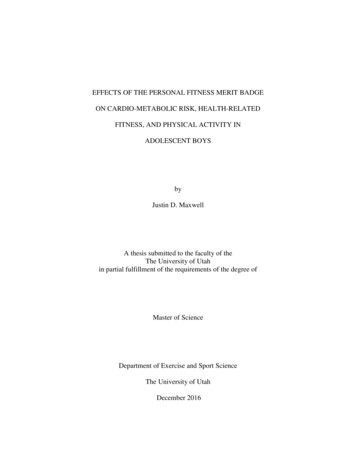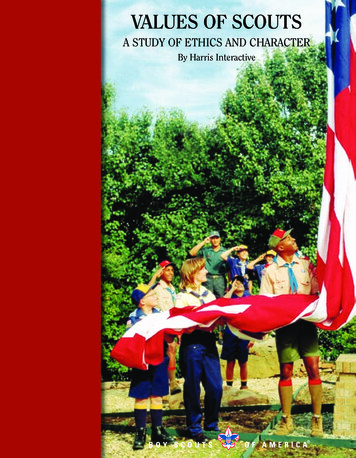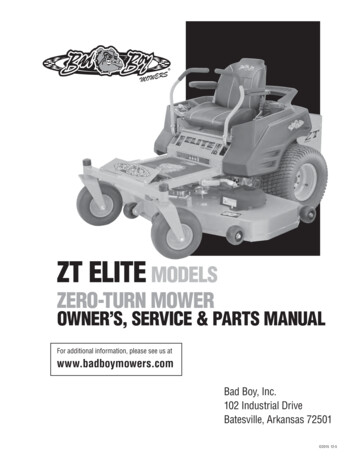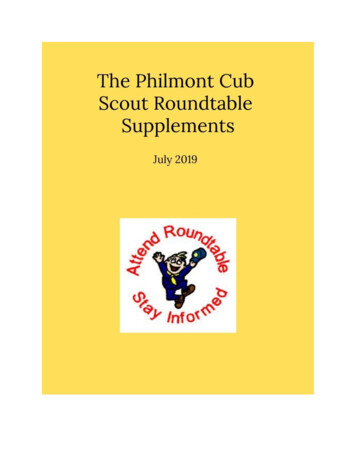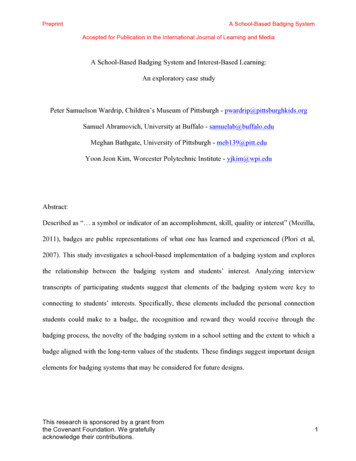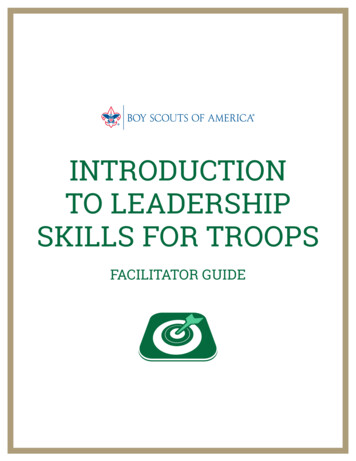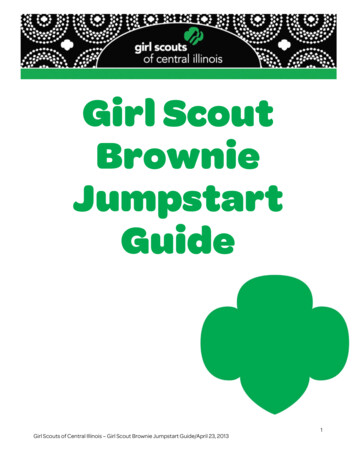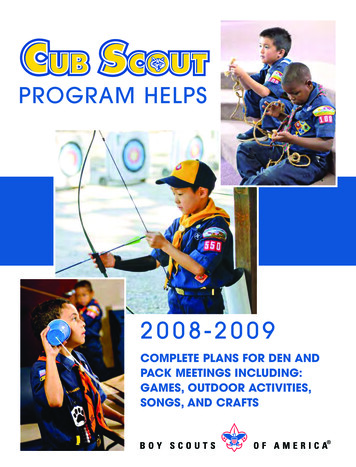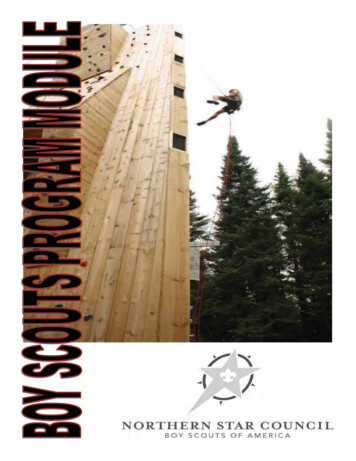
Transcription
2Northern Star CouncilBoy Scouts Program SyllabusScouting EmphasisContentsYear A Explanation5Fall Semester Weekly Outline/ Materials Needed6-9Opening10Week 1 Introduction to Boy Scouts11-14Week 2 Loyal15-19Week 3 Trustworthy20-24Week 4 Friendly25-30Week 5 Courteous31-35Week 6 Helpful36-39Week 7 Kind40-43Week 8 Cheerful44-47Week 9 Thrifty48-50Week 10 Brave51-53Week 11 Clean54-56Week 12 Obedient57-60
3Northern Star CouncilBoy Scouts Program SyllabusScouting EmphasisContentsSpring Semester Weekly Outline/ MaterialsNeeded61-64Week 13 Reverent65-67Week 14 Be Prepared68-70Week 15 Doing Your Part71-73Week 16 Citizenship74-76Week 17 Positive Attitude77-82Week 18 Courage83-85Week 19 Leadership86-88Week 20 Mini Challenges89-92Week 21 Maps93-97Week 22 Compass98-100Week 23 Athletics101-104Week 24 Athletics105-107Week 25 Great Outdoors108-110Week 26 Staying Healthy111-114Week 27 Healthy Eating115-118Week 28 Service119-122
4Northern Star CouncilBoy Scouts Program SyllabusScouting EmphasisContentsWeek 29 Making the Most of Yourself123-125Week 30 Court of Honor126-128Supplemental Activities129-132
5Northern Star CouncilBoy Scouts Program SyllabusScouting EmphasisFall SemesterDateWeek #1ActivitiesMaterials NeededScouting Intro, Scouts Into,GamesWriting utensils, posters and signs ofScout sign, Scout Salute and ScoutHandshake. Plain paper, Tape and Scissors.Scout Badge, Group juggling, Micro Scavenger Hunt2Writing utensils, Scout Badge worksheet and Soft balls.3EDGE: Knots, Creative Ex- Magazines*, Glue, Markers, Individualpressioncut ropes, Scissors , Writing utensils.4Requirement 10a, Marshmallow kick, throw andblow, Court of Honor Ceremony5Writing utensils, First aid worksheet,Circle stride ball, EDGE:markers, volleyball , chart paper, FirstFirst aid, First aid worksheetAid Kit (1 per aide)*.6Healing ground, Ice rescueFirst Aid supplies, writing utensils,rope, blanket, pole.7Sorry you missed, Thebucket story, EDGE: Broken bones and fractures,Role playingFirst Aid supplies, beanbags, small container, plastic bowls, pitcher of beads,small cup, writing utensils.8EDGE: Knots, Knot or not,Know your leafWriting utensils, plain paper, long ropeWriting utensils, 10a requirementworksheet, (3) marshmallows perScout, measuring tape and Boy ScoutBadges.
6Northern Star CouncilBoy Scouts Program SyllabusScouting EmphasisFall SemesterDateWeek #ActivitiesMaterials Needed9Keep away, School Boardmeeting, Bean and Knife relayWriting utensils, Computer with Internet, butter knifes, dried beans, (2)cups, plain paper.10Bomb Squad, alligator pitcrossingWriting utensils, bucket, tin can with 4dots on it, a dummy doll for CPR.,rope, pole.11Think fast, What is a family,Plain paper, Writing utensils, magazines, markers, glue, hangers*, string,colored paper.Family mobile12Candle duel, Family feudWriting utensils, long candles, squirtbottle*, water, bell or buzzer, chartpaper, lighter.* Designates that these items should be collected over time. We will collect as many of these items as possible for your units and distribute themevenly but please attempt to find these items on your own for your groups.
7Northern Star CouncilBoy Scouts Program SyllabusScouting EmphasisFall SemesterAdvancement CompletedWeek#BoyScouts11-5, 728 and 936 and 10Tender- SecondfootClassFirstClassMerit BadgeCommunication:3 and 64a and 4bCommunication:1d, 2a and 847,8,9,10aCommunication:7c and 9512a and12bFirst Aid: 5a, 5c,5d and 5f6First Aid: 1a, 2ad, 3a, 3d, 3e, 3f7First Aid: 4a-b,6a-b, 785,6,10b,11,13,14 and15
8Northern Star CouncilBoy Scouts Program SyllabusScouting EmphasisFall SemesterAdvancement Completed9Communication:4 and 510First Aid: 3b-c,5b, 5e, 5g, 5h,5i and 5j11Family Life: 1,2and 3Week#BoyScoutsTender- SecondfootClassFirstClassMerit Badge12Family Life: 4,5, 6a, 6b 1-313Family Life: 7ab14Family Life: 6b,4 and 515Citizenship inthe Community:5 and 6
9Northern Star CouncilBoy Scouts Program SyllabusWeek:1-30Date: WeeklyOpening Pledge, Oath, HandshakeOpening: Lead the Scouts in the Pledge of Allegiance and Boy ScoutOath. ( Utilize the posters to help). Have them hold the flag so all can see it.Have the Boy Scouts place their right hand over their hearts since they are notin uniform. Teach them the Boy Scout salute. As the Scout leader in uniform,you will do the salute.Pledge of AllegianceBoy Scout OathBoy Scout SaluteI pledge allegiance tothe flagOf the United States ofAmericaAnd to the republic forwhich it standsOne nation under God,indivisibleWith liberty and justicefor all.On my honor I will domy best to do my dutyto God and my countryand to obey the ScoutLaw; To help otherpeople at all times; Tokeep myself physicallystrong, mentallyawake, and morallystraight.Make the Scout salute byforming the Scout signwith your right hand andthen bringing that handupward until your forefinger touches the brimof your hat or the arch ofyour right eyebrow. Thepalm of your hand shouldnot show.Scout HandshakeScout SignThe Scout handshake ismade with the handnearest the heart and isoffered as a token offriendship. Extend yourleft hand to anotherScout and firmly grasphis left hand. The fingers do not interlock.To give the Scout sign,cover the nail of the littlefinger of your right handwith your right thumb,then raise your right armbent in a 90 degree angle,and hold the three middlefingers of your hand upward.Scout LawA Scout is trustworthy,loyal, helpful, friendly,courteous, kind, obedient,cheerful, thrifty, brave,clean, and reverent.
10Northern Star CouncilBoy Scouts Program SyllabusDate:Week:1Before MeetingTheme for this meeting: Intro to BoyScouts!!Before the meetingArrange room and gather supplies as neededLay out the attendance sheet with pencil/pen.Read pages 1 and 7 in the Boy Scouts HandbookRequired Material :x Paperx Attendance Sheetx Tapex Pencilsx Scissorsx Posters and Signs ofScout Sign, Scout Salute and Scout handshakeOpening and Opening ActivityOpening and Opening ActivityLead the Pledge of Allegiance with all Scout participants. Have Scouts placetheir right hand over their hearts since they are not in uniform.Pledge of AllegianceI pledge allegiance to the flagOf the United States of AmericaAnd to the republic for which it standsOne nation under God, indivisibleWith liberty and justice for all.*Collect Birthdays and ages of all Boy Scouts!Materials: Paper, Pencils and ScissorsOpening Activity: Introductions, Q&A HandsHave Scouts work in pairs to trace one of each other's hands. When the handsare traced, have them write one of the questions below or any other question ofyour choosing, on each finger of the hand.·What is your favorite TV show?
11·If you could choose your future career today, what would you be?·What is your favorite school subject?·If you could travel to anyplace in the world, where would you go?·What is your favorite sport to watch or play?You might provide Scouts with as many as ten questions. That way, they can pickand choose which ones they answer. Have Scouts write the answers to their questions on the fingers. When hey have finished with their Q&A hands, give eachScout an opportunity to introduce themselves to the Scouts by sharing the information they have written on their hands.Materials: Pencils and PaperDiscussion: Boy ScoutsDiscussionTalk about what the Scouts think Boy Scouts is.Discuss the only two rules of Boy Scouts. ( Follow the Scout Oath and ScoutLaw)Discuss what Boy Scouts promise to the Scouts. ( Page 1 in the Boy ScoutsHandbook)Explain and discuss the Scout Oath, Law, Motto, Slogan and the Outdoor Code.Scout Oath (have the boys repeat using the posters)On my honor I will do my bestTo do my duty to God and my countryAnd to obey the Scout Law;To help other people at all times;To keep myself physically strong,Mentally awake, and morally straight.Scout Law (have the boys repeat using the posters)A Scout is: Trustworthy, Loyal, Helpful, Friendly, Courteous, Kind, Obedient, Cheerful, Thrifty, Brave, Clean, and Reverent.Scout motto“Be prepared”It means to be ready for anything that comes along: a car accident, a drowningswimmer, a fire, or any other situation.Scout slogan“Do a good turn daily.”A “good turn” is a simple act of kindness or being helpful to someone else withoutexpecting anything in return. It could be opening the door for someone whosehands are full, going to the store for an elderly person, cleaning up trash in yourneighborhood, helping your brother or sister with school work, or doing the dishesfor your parents.
12The Outdoor CodeAs an American, I will do my best to be clean in my outdoor manners, Be carefulwith fire, Be considerate of the outdoors, Be conservation-minded.EDGE Engage, Demonstrate, Guide, EnableAsk the Scouts to come up with one thing they want to learn and are looking forward to accomplishing during the Boy Scouts program. Have Scouts write their answers down on a piece of paper.EDGE: ScoutsEngage: Introduce the Scout Sign, Scout Salute and Scout Handshake. Informthe Scouts on why they use these three things and when to use these three.Demonstrate: Show Scouts the proper way to do the Scout Sign, Scout Salute and Scout Handshake.Guide: Have Scouts practice the Scout Sign, Scout Salute and Scout Handshake in a large group. Go over when the Scouts would use each one again.Enable: Have Scouts pair up with each other and quiz one another on how todo the Scout Sign, Scout Salute and Scout Handshake.ActivityFun Activity: Around the RanksLabel four pieces of paper with the following: Boy Scouts, Tenderfoot, SecondClass and First Class. Put the four signs in the four corners of the room. Pickone Scout to be the guesser and have them sit with their head down. Theguesser will count to ten out loud. While the guesser is counting to ten, the other Scouts will find a corner to stand in. Once the guesser counts to ten, they willthen say a corner. All the Scouts in that corner will be out and have to sit down.The game continues until there is one Scout standing.Boy ScoutsTenderfootSecond ClassFirst Class
13Business ItemsClosing & DebriefDebriefHave Scouts write down two things they learned, one new question they have andone thing they liked about the meeting. Have each Scout go around and say onething from their list.ClosingHave all Scouts make a circle and put their right hand into the middle of the circle,on top of one another. Count to three and Scouts will raise their right hand out ofthe circle and shout “Scouts!”.Reminders:1. Please make sure you collect ALL NAMES andBIRTHDAYS of ALL Scouts!2.3.Notes:1.2.3.Boy Scout1-5, 7TenderfootSecond Class First ClassMerit Badge
14Northern Star CouncilBoy Scouts Program SyllabusDate:Week:2Before MeetingTheme for this meeting: LoyalBefore the meetingArrange room accordingly and gather all supplies needed for this meeting. Layout the attendance sheet and a pencil. Make sure to read pages 10 and 11 ofthe Boy Scouts Handbook. Also read over A Parent’s Guide on the inside of thefront cover.Required Material :x Soft ballsx Attendance Sheetx x PencilsScout Badge Worksheetx Micro Scavenger Huntsuppliesx How to protect yourchild pamphletOpening and Opening ActivityOpening and Opening Activity :Lead the Pledge of Allegiance with allScout participants. Have Scouts place their right hand over their hearts sincethey are not in uniform.Materials: Scout badge worksheet and PencilsOpening Activity: Scout BadgeGo over the Scouts Badge and have Scouts fill out the Scout Badge Worksheet.Parts of the Scout badge1. The top three points of the badge represent the three parts of the ScoutOath: duty to God & country, duty to self, duty to yourself.2. The eagle and shield stand for freedom and a Scout’s readiness to defendfreedom.3. The two stars represent truth and knowledge.4. The shape of the badge points north (like a compass) and means a Scoutpoints the right way in life.5. The scroll, with the Scout motto, is turned up at the ends as a reminder thata Scout smiles while doing his duty.6. The knot is a reminder of the Scout slogan, “Do a good turn daily.”Go over the pamphlet How to Protect Your Children From Child Abuse: AParent’s Guide on the inside of the front cover.
15Scout Badge WorksheetName:Opening and Opening ActivityDate:1)2)3)4)5)6)
16Materials: Soft balls or objectsActivity: Group JugglingHave team form a standing circle.Explain that the group will juggle a ballaround the circle with these rules:1. Must throw it to someone thathas not caught it yet.2. Must throw it to someone that isnot directly next to you.3. Last scout throws it back to the first scout.The leader should start with the ball. Once the ball has gone around, ask them torepeat the same pattern, throwing to the exact same Scout from the first time.Now, explain that the pattern is set - all you have to do is remember who youthrow to. We are now going to see how many balls we can successfully juggle.Now, give the group 1 minute to discuss strategy and improve their ball count. Donot give suggestions, but answer if you are asked if an idea is legal. For example,they may want to change places or roll the balls.DiscussionDiscussionHave the Scouts discuss what being loyal means (giving or showing firm andconstant support or allegiance to a person or institution). Have Scouts answerthe following questions:Who are some people they are loyal to?What are they loyal to?Ask Scouts if they know what the buddy system is? And what does the buddysystem mean? Next have each Scout write a 5 minute speech on the ScoutBadge or what it means to be loyal. Make sure Scouts include examples. HaveScouts present their speeches during a group meeting. (It may be best tohave half of the Scouts go at the end of this meeting and the rest of theScouts go at the beginning of the next meeting) Next have each Scout develop a plan to teach a skill or inform someone about something. Have eachScout prepare teaching aids for their plan. When finished decide whether or notthe Scout has taught the group what they intended.
17Activity: Micro Scavenger HuntEach patrol gathers in a separate spot around the activity area.The leader asks for a particular item and the first patrol to get it to him receives a point. Having a few requests (such as 5 wristwatches) that one patrol will most likely not have, but two or three working together could have,will cause the scouts to either give up or figure out to work together.Points should be given to both patrols that work together and are first to produce.DiscussionSome examples:x a pair of scissorsx a sock with a hole in itx a driver’s licensex a grey piece of stringx a square knotx exactly 63 centsx 3 phonesx 5 wristwatchesx a pencil or pen
18Business ItemsClosing & DebriefDebriefHave Scouts write down two things they learned, one new question they have andone thing they liked about the meeting. Have each Scout go around and say onething from their list.ClosingHave all Scouts make a circle and put their right hand into the middle of the circle,on top of one another. Count to three and Scouts will raise their right hand out ofthe circle and shout “Scouts!”.Reminders:1. Please make sure you collect ALL NAMES andBIRTHDAYS of ALL Scouts!2. Phase I3. Popcorn Sale!!!!!Notes:1.2.3.Boy Scout8 and 9TenderfootSecond Class First ClassMerit BadgeCommunication3 and 6
19Northern Star CouncilBoy Scouts Program SyllabusDate:Week:3Opening and Opening ActivityBefore MeetingTheme for this meeting: TrustworthyBefore the meeting: Learn and practice how to tie the square knot, two halfhitches, the taut-line hitch and whipping and fusing the ends of a rope. Readpages 8, 34, 36 and 37 in the Boy Scouts Handbook. Make examples for theCreative Expression activity. Think about and make notes on what the Scoutsare doing well on for the Scoutmaster Conference. Arrange room accordingly,gather all supplies and material needed.Required Material :x Paperx Magazinesx Attendance Sheetx Individual cut ropesx Gluex Pencilsx Scissorsx MarkersOpening and Opening ActivityAll Scouts and leaders join in the Pledge of Allegiance, the Scout Oath and ScoutLaw.Opening Activity: Two Truths and a LieGive the Scouts some time to come up with two truths and one lie. Scouts canremember them in their head or they can write them down. Each Scout willshare their two truths and a lie one at a time and the group will have to figureout which one is the lie.Materials: Large chart paper and MarkersDiscussionHave Scouts go around and say what they think it means to be trustworthy(able to be relied on as honest or truthful).Have the Scouts as a group come up with a list of trustworthy and untrustworthy behavior. Have Scouts discuss why it is important to be trustworthy.
20EDGE: ( Engage, Demonstrate, Guide, Enable) KNOTSEngage: Introduce why the square knot, two half hitches, taut-line hitch and whipping and fusing the ends of a rope is important. Engage Scouts in a discussion aboutwhen these things will be important for them to know. Also, what they can be usedfor.Demonstrate: Show the Scouts how to do the square knot, two half hitches, tautline and whipping and fusing the ends of the rope.EDGE Engage, Demonstrate, Guide, EnableSquare knot: Hold one rope end in each hand. Pass the right end over the left end.Wrap it under the rope in your left hand. Pull it snug. Next, pass the rope now inyour left hand over the one now in your right. Tuck the new left end under the onenow in your right. Pull it snug. If done correctly, the knot will slide loosely back andforth. Remember: RIGHT OVER LEFT, LEFT OVER RIGHT.Two Half Hitches: Used to attach a rope to a tree or post. Pass the end of the ropeover a pole. Bring the short end under the pole and back over the top of the longend (also called the standing end) of the rope. The rope should now look like a largenumber “4” with the pole through the open part of the “4”. Tuck the short tail of therope up through the opening of the “4”. Make another “4” with the rope just belowthe first one. This one will likely be much smaller than the first one. Make sure theshort end of the rope is on top of the long end. Tuck the short tail of the ropethrough the opening of the “4”. This is called two half hitches.Taut line hitch: A taut line hitch is used to keep a line tight or “taut”. Use it toloosen or tighten the ropes on your tent or dining fly at summer camp. Pass therope around a tent stake or other secure object. Bring the short end under the longend attached to the tent. Wrap the short end around the long end (passing throughthe opening) twice. Bring the short end over the top of the long end, and tuck theshort end through the new opening. Be sure to keep the knot neat while doing thisso it will grip tightly, Pull it tight. The knot will now adjust up or down to tighten upthe tent.
21EDGE Engage, Demonstrate, Guide, EnableWhip the ends of a rope to keep them from unraveling. Use a piece of twineat least 2 feet long. Make it into a loop and place this at the end of the rope. Wrapthe twine around the rope. When the whipping is as wide as the rope is thick.Tuck the end that has been wrapped around the rope through the loop at the end,pull the ends of the twine hard. Trim off the excess twine. Whip the other end ofthe rope.Fuse the ends of braided or synthetic rope by melting the ends over a candle to prevent the rope from fraying. WARNING!!! The rope will be very hot andcould catch fire. Do not touch it or another Scout until cooled for several minutes.If the end of the rope is placed in the flame or held too close causing the end ofthe rope to turn black. Burning plastic can also give off toxic fumes. If the end ofthe rope is held above the flame, unburned carbon particle will be deposited onthe melted plastic causing it to turn black. A candle flame will generate enoughheat to fuse the end of a rope up to about one inch in diameter.ATTENTION:Although there is little or no danger, it best to inform the school manager beforedoing this activity indoors. Because of the use of fire / flame, locations may askthat this activity be done outdoors.Guide: Partner the Scouts together and have them practice tying the square knotand two hitches. Once each Scout have attempted tying these knots, have theScouts try the taut-line and whipping and fusing the ends of the rope.Enable: Ask for one Scout to volunteer and show the large group how to tie thesquare knot and two half hitches.
22Activity: TelephoneHave Scouts form a line. Whisper a message to the first Scout in line (Such as“Boy Scouts Rocks”). The next Scout must then whisper it to the next Scout andso on. The Scout at the end of the line must say what he heard out loud. Seehow close it was to the original sentence. Try this one or two more time.Activity, Discussion, ActivityDiscussionDiscuss how the Scouts had to trust that their fellow Scout members would notchange up the message before it got to the end of the line. Next, discuss whatform of communication they used. Discuss and make a list of other ways to communicate with others. Pick two or three responses from the list and discuss whenthat might not be appropriate or effective form of communication.Materials: Paper, Markers, Pencils, Magazines and Glue.Activity: Creative ExpressionHave Scouts think of a creative way to express who they are to the large group.For example, a collage, a short story, drawing, song or a poem. Give Scouts timeto create how they would like to express themselves to the large group. OnceScouts are done, have them present what they came up with to the large group.Scoutmaster Conference: While each Scout is working on their presentationof themselves, take time to meet with each Scout. Go over what the Scout is doing well on, how the Boy Scout program is going for him and ask the Scout ifthere is anything that he wants to do that he has not had the opportunity to doas of yet. This meeting should be done in viewing and hearing distance of allScouts. At a table in the open will work just fine.*Remember leaders are to NEVER have one on one contact with Scouts!Have Scouts plan a Court of Honor for next week meeting. Pick one Scout toserve as master of ceremonies. Help guide Scouts on what should be included inthe ceremonies.
23Business ItemsClosing & DebriefDebriefHave Scouts write down two things they learned, one new question they have andone thing they liked about the meeting. Have each Scout go around and say onething from their list.ClosingHave all Scouts make a circle and put their right hand into the middle of the circle,on top of one another. Count to three and Scouts will raise their right hand out ofthe circle and shout “Scouts!”.Reminders:1. Get Boy Scout Badges for next week Court ofHonor Ceremony.2. Popcorn Sale!3. Phase INotes:1.2.3.Boy ScoutTenderfoot6 and 104a and 4bSecond ClassFirst ClassMerit BadgeCommunication1d, 2a and 8
24Northern Star CouncilBoy Scouts Program SyllabusWeek:4Date:Opening and Opening ActivityBefore MeetingTheme for this meeting: FriendlyBefore the meetingContact parents of Scouts that have earned their Boy Scout badge andinform the parents that they are invited to the Court of Honor Ceremony. Arrange room accordingly and gather all supplies needed for this meeting.Lay out the attendance sheet and a pen. Read requirements number 7,8,9 and10a on pages 7 and 8 in the Boy Scouts Requirement book. Also read page 75,requirements 7c and 9 in the Boy Scouts Requirement book.Required Materialx Boy Scout Badgesx Attendance Sheetx x Pencils3 Marshmallows perScoutx Measuring tapeOpening and Opening Activity: All Scouts and leaders join in the Pledge ofAllegiance, the Scout Oath and Scout Law.Materials: Worksheet for Tenderfoot Requirement 10aOpening ActivityHave Scouts do the followingPush-ups, Pull-ups, Sit-ups, Standing long jump and ¼ mile walk/ run.Scouts should fill out the their current results on the worksheet. Inform Scoutsthat they will be working on these things for 30 day and will record their finalresults then.DiscussionGo over the Scouts Oath, Law, motto and slogan and then have the Scoutsexplain what they all mean. Have Scouts come up with a patrol name, a patrolyell and create a flag to represent their patrol.
25Tenderfoot Requirement 10a RecordName:Before MeetingDate:Push-upsPull-upsSit-upsStanding long jump1/4 mile walk /runName:Date:Push-upsPull-upsSit-upsStanding long jump1/4 mile walk/ run
26Materials: 3 marshmallows per ScoutActivity: Marshmallow Kick, Throw and BlowDisclaimer: Make sure Scouts do not eat the marshmallows before, after or during.The Scouts will have had their hands feet and germs all over the marshmallowsmaking it very unsanitary for them to eat.Set up the kicking, throwing, and blowing stations separately so groups can rotatethrough them with minimized waiting.Kick: Each Scout stands at the kicking line and kicks one of his marshmallows asfar as he can. His distance is measured and tallied. You might have a rule that aScout can have a second attempt if it is missed or goes less than 1 foot.Discussion, Discussion, ActivityThrow: Each Scout stands at the throwing line and throws one of his marshmallows as far as he can. His distance is measured and tallied.Blow: Each Scout stands at the blowing line and puts a marshmallow in his mouth.He blows it as far as he can. His distance is measured and tallied.The winner is the one with the farthest combined distances. Or, do as a patrol competition and add up the Kick, Throw and Blow scores for each patrol member. Divide by number of patrol members to reach an average. Patrol with the highestscore wins.DiscussionHave the Scouts discuss sportsmanship and being friendly.Then have the Scouts describe what a bully is and how theyshould respond to one. Next have the Scouts produce a brochure, a newsletter, flyer, or other printed material for thegroup. The Scouts must include one article and one photograph or illustration.Discussion:Have the Scouts make a list as a class about 3 career opportunities in communication. Have them choose one and find out about the education, training, and experience required for this profession.Have them explain why that profession may interest them.Discuss with the Scouts about upcoming camping opportunities see if any Scouts have ever been camping and go oversome of the rules and guidelines when camping.
27.Courtof Honor:Welcome to all our guests, especially the parents of the Scouts ofTroop (troop number). We are here today to recognize theseScouts for several weeks for hard work. They have learned the idealsof Scouting – the Scout Oath and Scout Law and they are still learning. They have learned about teamwork and they are still learning.They have learned about responsibility and they are still learning.They have learned about leadership and they are still learning.You probably noticed that one of our Scouts opened the meeting. He isScout (name of Senior Patrol Leader). He is our Senior Patrol Leader –the senior Scout in the troop, elected by his fellow Scouts. This leadership position will rotate twice a year to allow all the Scouts an opportunity to lead.Court of Honor CeremonyBy the power invested in me by the Boy Scouts of America, I herebyconvene this Court of Honor to recognize these Scouts.Boy Scout rankThe Boy Scout badge is the first step along the trail to that of EagleScout. It is not an easy trail, but it is one that is attainable. To reachthis first step, these Scouts had to learn the Scout Oath, Scout Law,Scout handshake, Scout sign, Scout salute, and the Pledge of Allegiance. They also had to each participate in a personal growth agreement conference in which they set goals and plans for future achievements.Would Scout (call a Scout’s name) please come forward. Are yourparent’s here to join you? Parents, please come up here, too. Parents,please pin your son’s Boy Scout badge on his left shirt pocket.Call each Scout forward one at a time and complete the same process.Also have individual awards as well as participation awards.CLOSINGSenior Patrol Leader calls the troop to attention. All Scouts give theScout sign and recitetogether the Scout Law. The Senior Patrol Leader reads the points ofthe Scout Law with the Scouts repeating each point, as below:Senior Patrol Leader: A Scout is trustworthy. Scouts: A Scout is trustworthy.Senior Patrol Leader: A Scout is loyal. Scouts: A Scout is loyal.Senior Patrol Leader: A Scout is helpful. Scouts: A Scout is helpful.
28Senior Patrol Leader: A Scout is friendly. Scouts: A Scout is friendly.Senior Patrol Leader: A Scout is courteous. Scouts: A Scout is courteous.Senior Patrol Leader: A Scout is kind. Scouts: A Scout is kind.Senior Patrol Leader: A Scout is trustworthy. Scouts: A Scout is trustworthy.Senior Patrol Leader: A Scout is obedient. Scouts: A Scout is obedient.Senior Patrol Leader: A Scout is cheerful. Scouts: A Scout is cheerful.Senior Patrol Leader: A Scout is thrifty. Scouts: A Scout is thrifty.Senior Patrol Leader: A Scout is brave. Scouts: A Scout is brave.Senior Patrol Leader: A Scout is clean. Scouts: A Scout is clean.Senior Patrol Leader: A Scout is reverent. Scouts: A Scout is reverent.Court of Honor CeremonyScoutmaster: Thank you to our guests for coming.
29Business ItemsClosing & DebriefDebriefHave Scouts write down two things they learned, one new question they have andone thing they liked about the meeting. Have each Scout go around and say onething from their list.ClosingHave all Scouts make a circle and put their right hand into the middle of the circle,on top of one another. Count to three and Scouts will raise their right hand out ofthe circle and shout “Scouts!”.Reminders:1. Phase I: Camping opportunity. Call Bobby2.3.Notes:1.2.3.Boy ScoutTenderfoot7,8,9,10aSecond ClassFirst ClassMerit BadgeCommunication7c and 9
30Northern Star CouncilBoy Scouts Program SyllabusWeek:5Date:Before MeetingTheme for this meeting: CourteousBefore the meetingRead pages 296, 297, 304, 306, 307, 308, 310, 312, 31
Week 30 Court of Honor 126-128 Supplemental Activities 129-132 . 5 Northern Star Council Boy Scouts Program Syllabus . ward to accomplishing during the Boy Scouts program. Have Scouts write their an-swers down on a piece of paper. EDGE: Scouts Engage: Introduce the Scout Sign, Scout Salute and Scout Handshake. Inform
